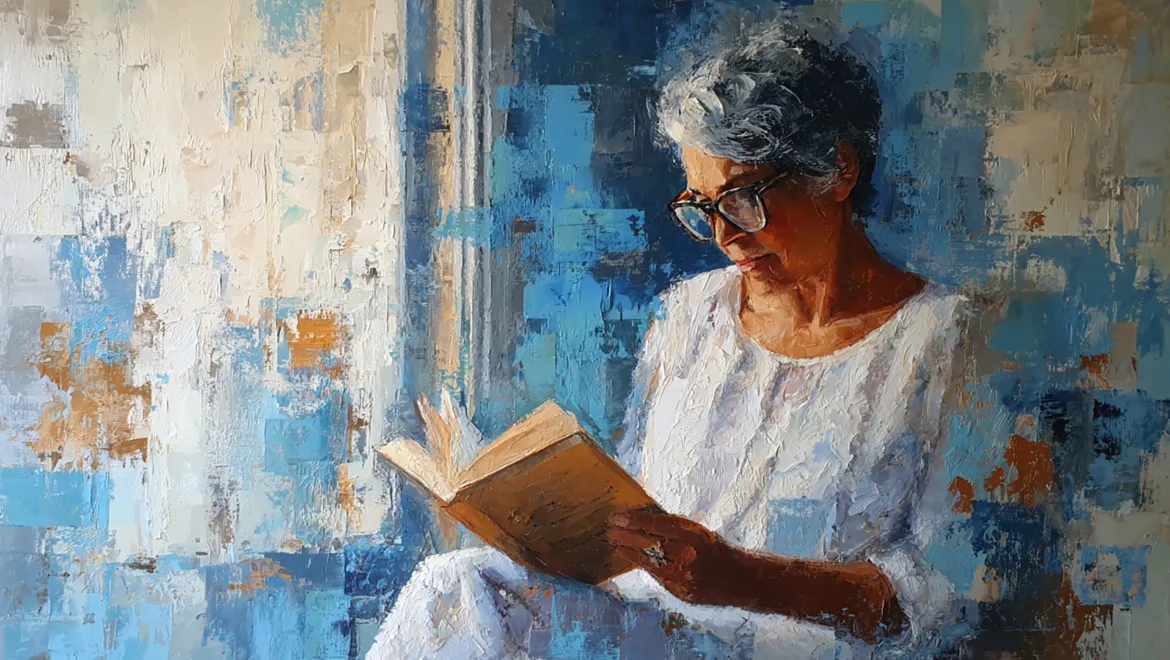I’ve always remembered a romance book I read in my twenties, though the title is lost to time. The hero was a tall, broad-chested Viking lord, the heroine a small and feisty thrall who gave as good as she got. There was snappy banter, power struggles, and the inevitable growling sex when the hero could no longer stand the heroine’s denials.
When I read those scenes on my college futon, wrapped in a quilt with snacks in my lap, I could disappear into that fantasy. I wanted to be wanted that way: fiercely, urgently, driving a man wild.
I don’t want that anymore.
It’s not that those books were bad. They gave me exactly what I needed then. But somewhere in my forties, around the time I got my first pair of reading glasses, I started skimming the sex scenes, then skipping them. They stopped feeling like an invitation and started feeling like a reminder: this isn’t written for you anymore.
What Changed
I’m fifty now. My body moves differently than it did; my knees protest stairs, the snacks are forbidden lest they give me heartburn, and yes, I need reading glasses to see the small print. My calendar is full, my responsibilities endless. On the rare occasions I pick up a romance, I still want heat and desire, but I want it to feel like it belongs to the world I actually live in.
When the heroine in a book has glowing skin, a young body that never aches, a life with no interruptions, it puts me outside the story, like I’m watching through a window. I can see it, but I can’t feel it. It’s not that I want a book where the heroine does laundry and obsesses over her body. I don’t. But I’ve grown out of pure escapism and into something else. I want stories that make me believe desire is still possible for a woman like me.
I want a hero who wants a woman with an older body. Not despite it. Because of it.
The Book That Reminded Me What I Was Looking For
I almost gave up on the genre entirely. Then a friend handed me a worn paperback and told me, “Just try this one.”
The heroine was forty-seven. Divorced. She reached for lube without apology. She and the hero had a conversation mid-scene about what felt good and what didn’t, not because the author was trying to teach me something, but because that’s what adults do. At one point, she laughed—actually laughed—when something went awkwardly, and he laughed with her. When the scene ended, they didn’t leap into the next plot point. They lay there. They talked. The intimacy lingered.
I sat on my couch, reading glasses perched on my nose, and something in my chest unclenched. This, I thought. This is what I’ve been hungry for.
What a Scene Needs to Work for Me Now
I want bodies that feel lived in. A heroine who hesitates before undressing because she’s self-conscious about the softness of her belly, and a partner who loves her anyway—no, who loves her because she’s spent decades in that body, because it’s hers. I want to see someone reach for reading glasses to check a text from their lover, or who wonders if this person will truly fit into their life. Not because those details are the point, but because they’re real, and real makes the intimacy land.
And I want what happens to matter. The next morning’s text. The way they look at each other across the kitchen, something changed between them. Intimacy in midlife carries more weight because it requires more vulnerability. I want to feel that weight on the page.
When I write now, I think about what that Viking lord story wasn’t. I want to write imperfections and authenticity. In Painting Celia, I wanted the intimacy to feel grounded in Celia’s fear of being seen and León’s selfishness. For Kelsey, in the book I’m writing now, I’m exploring a midlife heroine navigating desire alongside career reinvention, a toddler, and a new post-child body. I want to show her hesitation, her interiority during intimate moments. It’s hard but rewarding.
Giving Yourself Permission
For years, I kept reaching for the kinds of books I loved in my twenties, wondering why they didn’t work anymore. It took me too long to realize: I’ve changed. My body has changed. My life has changed. Why wouldn’t my reading taste change too?
Now I scan blurbs and reviews for clues. I look for “midlife,” “seasoned romance,” “older heroine.” I check Goodreads tags. I ask for recommendations from readers who get it, because I want to feel the story, not just watch it from a distance. And there’s no shame in that. There’s no shame in wanting to feel, at fifty, like desire is still meant for you.
The point isn’t that we age out of sex or passion or heat. It’s that we grow into a different kind of pleasure, one that’s more textured, more specific, more grounded in who we’ve become. I still want butterflies, but I also want the hero who finds the reading glasses on the nightstand and hands them to the heroine with a smile, who sees her exactly as she is and wants her anyway. I want the scene that makes me believe it’s still possible. Not in some far-off fantasy world, but here. Now. In this body. At this age.
If you’re navigating this same shift, I’d love to hear: what do you look for in intimate scenes now, and how has that changed for you? What books have gotten it right? Let’s build a list together.
And if you’re curious about the publishing side—how small presses can actually build these stories into their catalogs—I’m writing about that over on Lingua Ink. Because this conversation isn’t just about what we want to read. It’s about making sure those books exist.

